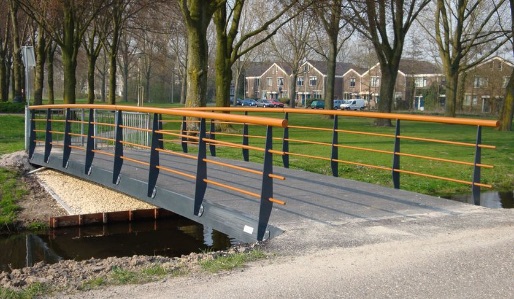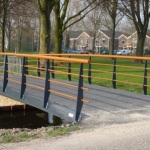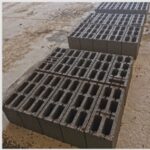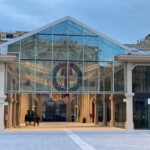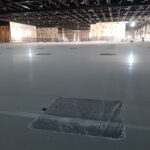When it comes to architecture and design, the Dutch port city of Rotterdam isn’t exactly known for playing by the rules or abiding by conventions. A town of gritty docklands, shiny modern high-rises and one hell of a market hall, the Netherlands’ second most populous city boasts a singular energy — dizzying, delightful and frequently jarring, it’s an energy borne from a continued emphasis on the innovative and the avant-garde. There’s nowhere else in Europe quite like it.
That all said, of course Rotterdam city leaders have taken an atypical yet intelligent approach to a major infrastructure project that involves gradually replacing the city’s extensive network of aging wooden pedestrian and cyclist bridges. In lieu of sticking with traditional wood or opting for concrete and steel when erecting replacement bridges, Rotterdam has turned to plastic.
While bridges built from plastic may not immediately make much sense, keep in mind this is a city that’s seriously considering forgoing asphalt and paving its highways with recycled plastic water bottles. And while the plastic paving scheme is still very much in the conceptual stage, the plastic bridge-building scheme has been quietly active since 2009 when the city erected its first pedestrian span from fiber-reinforced polymer (FRP), a versatile plastic composite material.
In total, there are roughly 850 dedicated pedestrian – and cyclist-dedicated bridges crisscrossing Rotterdam’s many canals. To date, around 90 of them – largely older ones that have seen better days – have been replaced with newfangled plastic bridges, making Rotterdam the official plastic bridge capital of the world. And as older wooden footbridges continue to fall into disrepair, the city plans to keep on replacing them with plastic ones.
The city project manager Dave Geensen spoke on the trend, detailing the myriad benefits of opting for FRP over conventional bridge-building materials like concrete or steel.
First off, while these replacement bridges are safe and structurally sound, they do indeed feel different to the pedestrians crossing them – even a bit shaky, maybe. ‘It may feel a bit wobbly at first,’ Genseen says. ‘That’s something you have to get used to. But we haven’t had any complaints about it.’
That’s good because the benefits of erecting bridges with lightweight plastic composite materials are vast. For one, there’s the speed factor. Traditional footbridges made from steel, concrete or wood take a while to complete – weeks, even months. But as Geensen explains, a plastic bridge can be installed in just a single day. This extreme efficiency, of course, minimizes detours and other pesky disruptions while saving precious time, money and resources. ‘It’s a really light material, making it really easy to put out there,’ says Geensen.
In addition to speed, plastic composite-based bridges boast exceptional longevity and are relatively low-maintenance compared to conventional building materials. Repairs and routine upkeep are rather easy while the need for total replacement every couple of decades is rendered null. While wooden bridges might need to be replaced every 25-30 years, FRP bridges last as long as a century.
‘Our main goal was to construct bridges using materials which require the lowest possible maintenance costs and could last longer than a lifetime,’ Geensen says.
Despite being long-lasting and low-maintenance, bridges built from petrochemical-based plastic aren’t going to win any awards in the sustainability department. However, concrete and steel require significantly more energy to produce than FRP materials so there’s that advantage. What’s more, composite manufacturers are continuing to experiment with bio-based materials with hopes that renewable, plant-based materials will ultimately replace oil.
Rotterdam-based FiberCore Europe has partnered with the city to erect the new bridges, which as the company points out, can also be easily moved if ‘urban infrastructure is revised.’ And while they’re meant to last for the long-haul, the bridges are also fully recyclable at the end of their useful lifespan. In 2013 alone, FiberCore developed the construction for 32 new pedestrian bridges in Rotterdam.
In addition to bridges designed for foot- and bike-traffic, FiberCore has also developed and executed heavier load accommodating FRP bridges geared for vehicular traffic across the Netherlands and further afield. And because not just humans benefit from bridges, the company has also developed “Ecoducts” — that is, specialized prefabricated wildlife crossings that allow critters to safely traverse potentially dangerous roadways.
In 2009 the city erected its first pedestrian span from fiber-reinforced polymer FRP (Photo: FiberCore Europe)


